-
- (NOTE: see also the updated article by the same name contained in the Summer 2021 Sego Lily which contains a postscript plus higher resolution as well as additional pictures.)
- In 1954, Rudy Drobnick, a University of Utah graduate student of the famous botanist and conservationist Dr. Walter P. Cottam (1894-1988), initially noticed a hybrid on the west side of the Oquirrh Mountains (which run north and south along the west side of the Salt Lake valley). Later in the course of Drobnick's research for his master's thesis, more isolated occurrences were found including locations, amazingly and somewhat ironically, very near to what would become Cottam's Oak Grove (and which then led to all of Cottam's famous work that continued unabated for the remainder of his life) at Red Butte Garden, on the University of Utah campus in Salt Lake City.
- These naturally occurring oak hybrids involve a cross of between Quercus gambelii (Gambel's oak, also called Gambel oak, scrub oak, Rocky Mountain white oak or Utah white oak) and Quercus turbinella (Turbinella live-oak, Turban oak or Sonoran scrub oak). Taxonomically they are known as Quercus x pauciloba Rydberg (Few-lobed oak) but can be designated in other ways.
- About Gambel's oak
- Gambel's oak was named by Thomas Nuttall in 1848 for ornithologist/naturalist William Gambel who in 1841 collected it in northern New Mexico. (Gambel was only about 20 years old at the time; sadly he died of typhoid only a short number of years later in 1849). It is widespread along Utah's Wasatch Front and is typically thought of as a shrub to small tree since most frequently it is found in less favorable dry/rocky habitats growing in groves or thick stands; so, it is an important soil stabilizer, particularly in light of its extensive woody, thick root system (lignotubers) and its clonal nature. But given the right location such as in canyon bottoms, it can form dense stands and grows straight and can easily reach heights of well over 35 feet. Gambel's oak is deciduous; Turbinella live-oak is evergreen and never grows as tall as Gambel's can, is usually in the four to eight foot range, and has smaller, holly-like leaves that come to sharp and almost spiny points. It is now restricted to extreme southern Utah in Kane, San Juan and Washington counties. Gambel's oak occurs primarily at 4500 to 7000 feet in the Central Wasatch Front (but can be found at higher elevations). Turbinella live-oak grows generally at lower elevations.
- Typical Gambel's oak community in northern Utah (9/18/08 Olympus Hills Park)

Gambel's oak acorns (9/6/08 U of U Research Park area) 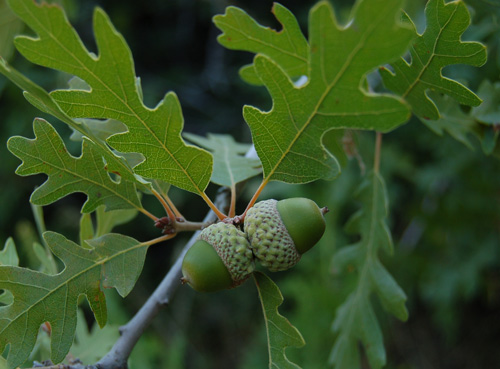
Acorns are a prized and important food for a variety of wildlife including birds, squirrels, deer,
bear and probably the buffalo that once roamed the Salt Lake valley until the late 1830's.
They were also widely used by Native Americans. The trees generally are very important for wildlife.Mature Gambel's oak acorns
(11/22/08 Dimple Dell Regional Park)
- While Gambel's oak has been reported from almost all counties in Utah (except Daggett and Rich) and comes into contact with Q. turbinella (in Washington County) and is generally widespread, its actual distribution in Utah can be thought as along the I-15 corridor and all along our north-south mountain ranges, and to the east (mainly southeast). It is largely absent from Utah's west desert and from the Great Basin. So its presence in Box Elder, Tooele, Juab, Millard, Beaver and Iron counties is limited to their extreme eastern edges.
- Gambel's oak fall leaves (10/21/08 Olympus Hills Park)

Gambel's oak leaves turn red or, more often, yellow-brown in the fall (10/21/08 Olympus Hills Park) 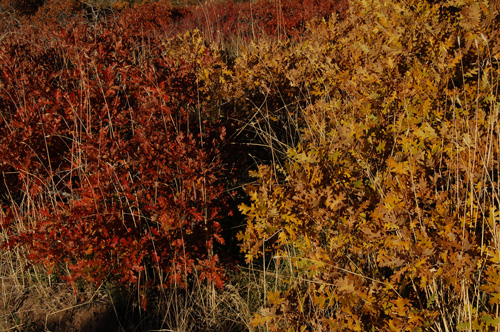
- Utah is in fact at the growth center of Gambel's oak distribution in the U.S. as it tends to be the most prolific here. Restricted primarily to the western United States, it is not reported from Idaho nor Oregon and it is limited in Wyoming to the southeastern part of the state. While occurring in Nevada, it is mainly known there from the southwestern portion of that state. It also occurs in Colorado, New Mexico, Arizona and in scattered locations in Texas and northern Mexico.
Gambel's oak grove showing arborescent growth form (11/20/08 Olympus Hills Park) 
- Gambel's oak is itself thought to be of hybrid origin and is known to form other hybrids. A rare variety of Gambel's oak is Quercus gambelii var. bonina (Goodhope oak) known from only one population in San Juan County, Utah, and is aborescent rather than clonal, and appears to be a fast growing, riparian small tree. A species named in 2003, Quercus welshii (Shinnery or Tucker's oak), and which can often be found buried in sand with only its tips exposed, is known to form hybrids or intermediates with Q. gambelii and Q. turbinella. In Utah Q. welshii is also only found in the southern part of the state but does occur over a wider area and more to the north than Q. turbinella.
- Back to the northern Utah hybrids: when?
- So when did these two species hybridize in northern Utah? Cottam (1959) suggested that neither Q. turbinella nor probably Q. gambelii survived the Wisconsin glaciation (which ended about 10,000 years ago). Sometime during the Middle Holocene (5,000 to 8,000 years ago) a drier period occurred which allowed plants and animals better adapted to arid conditions to move northward (a period during which species richness is thought to have decreased). Cottam believed that Q. turbinella then spread up primarily along the western edge of the Wasatch Front (essentially along the Lake Bonneville shoreline). Thereafter, cooler conditions prevailed forcing Q. turbinella to be pushed back to the south leaving Q. gambelii and the stranded hybrids which were only able to survive vegetatively.
- Based on northern Utah and southern Utah/northern Arizona (locations where the parent species occurred) temperature data collected from 1956 to 1957, Cottam posited that a distant past climate event created less warmth from late fall to early spring. This he thought might be the critical factor that would account for the current distribution of the parents as well as explain the presence of the stranded hybrids.
- The research of University of Utah biogeography professors Ron Neilson and Leroy Wullstein (published in scientific articles in 1983 and 1986) suggested that where Gambel's oak is less common, it reproduces sexually, and where it is more abundant at its northern limits, its primary reproductive method is asexual, and that Gambel's oak seedlings require summer rains and adequate moisture to survive. They concluded that Gambel's oak became established in a mid-Holocene environment when summer moisture was more reliable.
- In a 1996 article, University of Utah plant ecologists Jim Ehleringer and Sue Phillips noted that there were no firm age estimates for the hybrid oaks. Their research suggested that the lack of summer rains may have been the critical factor that caused Turbinella to recede, and that the climate event that decreased or lessened summer monsoons in northern Utah took place well less than several thousand years ago. In fact, based on the loss of corn in the diet of Indians along the Wasatch starting about 700 years ago and the analysis of certain hybrids of Pinus edulis (Pinyon pine) that are less then 400 years old, the loss of summer moisture may have begun relatively recently. Hybrids left behind were able to continue to survive because they were not dependent on summer rains. This they explained is also related to the fact that Gambel's oak has a deeper and more developed root system than Turbinella. These findings were highly consistent with the observations and conclusions of Neilson and Wullstein.
- The Ehleringer-Phillips explanation as to why Q. turbinella is now no longer able to persist north of its current distribution is compelling in several respects and leads to one to the conclusion that these hybrids could be less than 750 years old. This would coincide with the exodus of the Anasazi during the droughts of the late 12th and especially the late 13th century. It would also make more sense in light of the history of Lake Bonneville. About 15,000 years ago, Lake Bonneville was at its highest level (and as high as about 5,100 feet). By 10,000 years ago, the lakes in Utah west desert were mostly dried up and the Great Salt Lake had reached an elevation of about 4,200 feet where it has since remained. The climate change event relating to the ultimate disposition of these oaks and the stranded hybrids seemingly was something perhaps somewhat more subtle (although still of great consequence) and something that might have occurred much more recently than originally suggested by Cottam.
- Another reason that supports the notion that these hybrid oaks are of more recent origin relates to reported ages of the two "parent" species. Several sources suggest that Gambel's oak reaches old age at approximately 80 years. Turbinella is reported to grow much more slowly. Even if Turbinella itself can live for thousands of years (a fact for which evidence does not appear to be readily available), a hybrid with an oak that typically lives for less than 150 years seems logically more likely to produce a shorter life expectancy than indicated by Cottam (and especially when the northern Utah hybrids are typically intermediate between the two parent species). Even if so, this does not negate the basic concept and premise that Cottam used to explain the presence of the hybrids. And, it shows how relatively minor, recent climate changes may have had significant impacts.
- Well-known Brigham Young University native plant taxonomist Dr. Stanley Welsh has suggested that the hybrids have occurred as a result of long-distance pollen dispersal. This notion was specifically discounted by Cottam, and other knowledgeable biologists do not accept this explanation (see references section for more information).
- The Dry Creek hybrid
- On Saturday November 15, 2008, UNPS co-president Dr. William "Bill" Gray (U of U emeritus biology professor) and I were fortunate to visit one of these naturally occurring hybrids thanks to University of Utah biology professors Drs. Lynn Bohs and John Sperry. This is one of the earliest hybrids discovered by Rudy and is referred to as the "Dry Canyon" location by Cottam (1959).
- Few-lobed hybrid oak growing in Gambel's oak stand (11/15/08 at Dry Creek north of U of U Hospital)

- (surrounded by mostly non-native grasses, most noticeable here is the invasive Secale cereale
(cereal rye, a revegetation/forage plant gone bad that is, along with others, threatening our
remaining foothill natives in Salt Lake County)Closer view of plant (11/15/08) 
- Few-lobed hybrid oak leaves (11/15/08)
-
Comparison of Q. turbinella (left), the hybrid Q. x. pauciloba (middle) and Q. gambelii (right) (click for larger image) 
- About the leaves above: the Q. turbinella leaves had previously been properly obtained from the somewhat nearby Cottam's Oak Grove by a biology professor for a recent biology class and had been discarded. The leaf tips were spinescent, and the leaves tough and stiff. (Q. turbinella is not known to naturally occur in this area). The hybrid leaves were taken from a branch that was already separated from the hybrid tree clump/clone on 11/15/08. In addition to shape/size, they have a relatively rough texture compared to Gambel's oak due to pubescence. The lobe tips are not spinescent. The Gambel's oak leaves were taken from the Olympus Hills Park area on 9/27/08 and not from the Dry Creek area. The upper/right leaves were from a representative tree/shrub where the leaves were turning yellow/brown as is commonly the case, but from an immediately adjoining tree/shrub with the same aspect/elevation/exposure/slope/size, the leaves on that adjacent oak (lower/right) were turning red and were smaller and had a somewhat less smooth/shiny surface texture. Gambel oak leaves are incredibly variable and can be much larger than these, and deeply lobed/shaped in numerous other ways. Note also that these are leaves from upper branches yet oaks in general (and not unlike many other plant species) typically have differently shaped lower leaves that can also be much larger.
- Late October/November is the time to look for these distinctive hybrids. After roughly December 1, they too will have lost their leaves. The Gambel oaks will generally be bare, growing around the fading but darker green-leafed hybrids.
- The Dry Creek plant clump above (maybe 20 feet by 10 feet in overall area) was growing right within and at the edge of an existing colony on a fairly steep slope. It may be infertile. Speculation is that the plant could easily be well over 1,000 years old.
- A chat with Rudy
- On November 17, 2008, I was privileged to have had a phone conversation with Rudy Drobnick (who has been with the Division of Wildlife Resources, State of Utah, now for 51 years). He indicated that on this same Saturday past, he and "Chuck" (U of U emeritus geography/biology professor Dr. Leroy H. Wullstein) had been on the west side of the Oquirrhs looking at the most significant hybrid oak find yet: a group of some 12 or so hybrid oak plants. Usually a single plant/clump is found.
- In all he thinks there may be about 55 plants (43 of those representing plants he has previously found north of where Q. turbinella now grows in southern Utah) with the northernmost occurrence located east of Ogden, Utah.
- He indicated that a perfect grad student project, and the highest priority task, would be to go out and GPS each and every occurrence.
- When asked about their fertility, he said that most hybrids are fertile but that birds and squirrels usually take away the acorns before they ever have a chance to hit the ground; September is a good time to re-visit plants and check for acorns.
- He also mentioned that Chuck saved plants from being destroyed at This is the Place Heritage Park, and that they are trying to save one right now on Traverse Mtn. on the new Alpine road west of Highland that is on private property in northern Utah County, which is immediately south of Salt Lake County. Occasional/rare hybrids have been found elsewhere in Utah County such as in Springville.
- Hybrids in George's Hollow
- On November 20, 2008, Bill Gray invited me to tag along with him and the enthusiastic Dr. Wullstein ("Chuck") to see the the hybrids at George's Hollow (south of Red Butte Garden). Somehow we survived the military training exercises and blustery conditions. This is another one of the original locations found by Rudy in the late 1950's and Chuck believes that the colony is about the same size then as now. Growing almost to the ridgeline at about 5,650 feet on a steep slope, these plants are facing to the south/southwest unlike the Dry Creek occurrence. The plants were overall "less green" than the Dry Creek plant but still had many greenish leaves. These plants seem to be more prickly and in fact one of the clones is thought to be a back-cross to now long gone Q. turbinella.
- Bill Gray inspects an oak hybrid at George's Hollow (11/20/08)
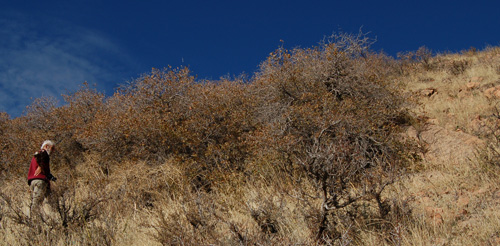
Hybrid oak leaves at George's Hollow (11/20/08) 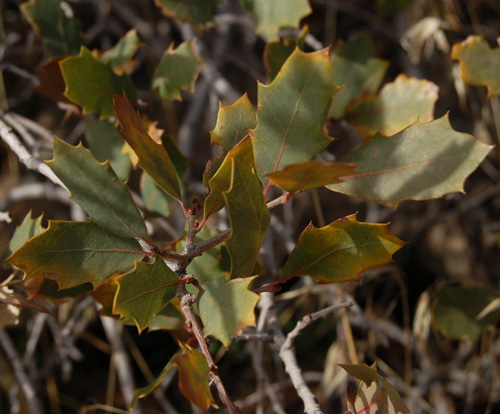
- Bill and Chuck look at the back-cross (11/20/08)

- The hybrid is in the foregound.
Salt Lake valley from George's Hollow hybrid's perspective (11/20/08) 
- Leaving hybrid oak habitat (11/20/08)
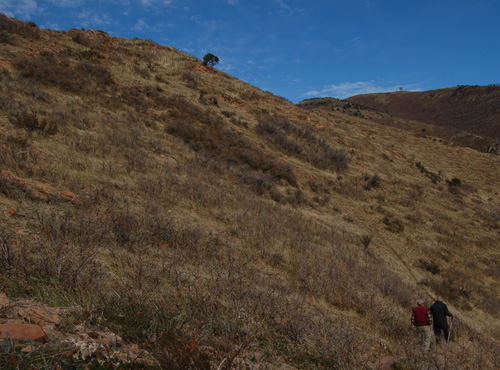
- Hybrid habitat is at center to upper left.
- Gambel's oak frames downtown Salt Lake City and the northern Salt Lake valley as we return to our vehicles (11/20/08)
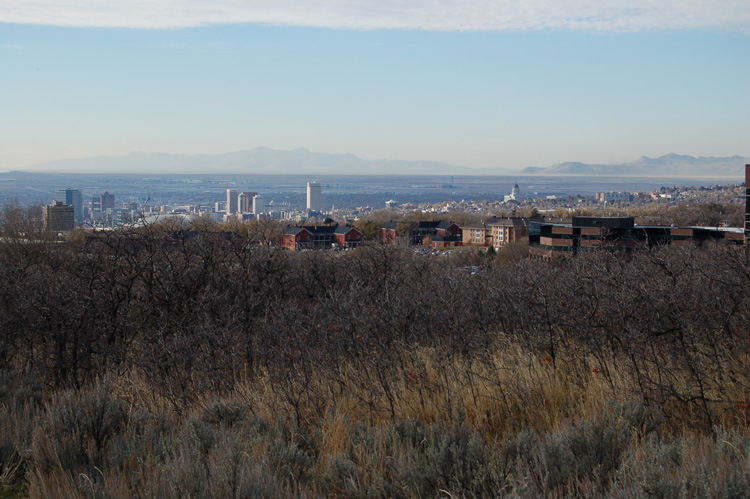
- Hybrids saved at This is the Place Heritage Park
- After visiting the George's Hollow plants, we stopped at the This is the Place Heritage Park (just south of the University of Utah) occurrence relatively recently discovered by Chuck (see July 2007 link to the Associated Press article below as well as Warchol, 2007). Commercial development proposals could have destroyed these plants, but thanks to Chuck's advocacy and intervention by Larry Miller, the plants were saved. Now there is a well-maintained, low impact trail though the hybrid oaks which have become an important part of the park's interpretive activities (and perhaps have helped to change or least expand the focus of the park somewhat).
- Signage at This is the Place Heritage Park (11/20/08)
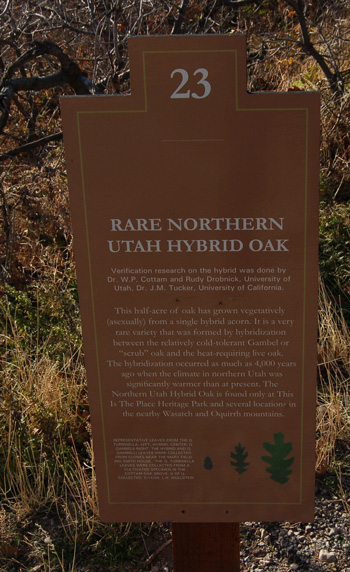
- The plants growing here at about 4,960 feet are in marked contrast to those at Dry Creek and George's Hollow. Here the terrain is flat and the plants are growing intertwined with Gambel's. They had already lost all of their leaves and one plant could not be distinguished from another. Based on fallen leaves, Chuck showed us how the lobes of these leaves were pointed (rather than having the characteristic rounded lobes of Gambel's). But their leaves are much more "Gambel-ish" and it is apparent that these plants are closer to Gambel's than to Turbinella. Their identities as hybrids were however confirmed by oak expert Dr. John Tucker prior to his recent death on July 5, 2008. John was a professor emeritus of botany at the University of California. The herbarium's name there was changed to the J.M. Tucker Herbarium upon John's retirement in 1986.
Oak grove at This is the Place Heritage Park (11/20/08) 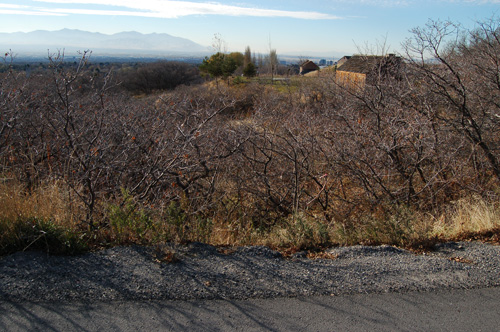
- Chuck at This is the Place Heritage Park near hybrid oak grove (11/20/08)
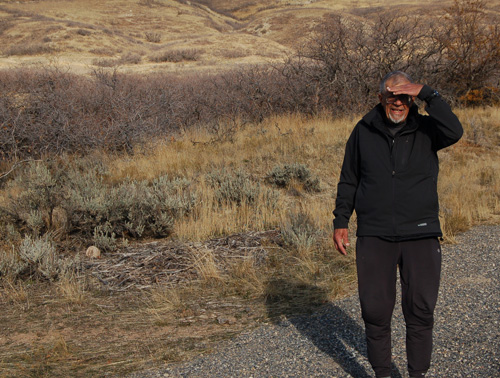
- The future of these hybrids in northern Utah
- There is a concern that ongoing University of Utah developments and expansion could inadvertently lead to the destruction of one of these ancient, living fossil gems. A hybrid oak formerly known from north of the base of Big Cottonwood Canyon is already now gone. Hybrid oak habitat on the Traverse Mountains has been significantly altered. The trees cannot be simply moved or transplanted, and other than through cloning (via its underground stems), they may have no way to propagate themselves and may now be in decline. Their occurrences need to be treated as rare and unique elements of our natural world that need to be preserved not only for their beauty but also as a critical resource: they may help us to answer questions about the past, and ultimately our future.
- References, resources and more information:
- Scientific articles
-
- Cottam W, Tucker J, Drobnick R. 1959. Some clues to Great Basin postpluvial climates provided by oak distributions. Ecology 40(3): 361-377. doi:10.2307/1929752
- It is indicated here that many of the naturally occurring hybrids were thought to be infertile.
- Drobnick. R. 1958. The ecology of a relic hybrid oak in the Great Basin area of Utah. Unpublished thesis. Salt Lake City, Utah: University of Utah. 96 pp.
- Neilson RP, Wullstein LH. 1983. Biogeography of two southwest American oaks in relation to atmospheric dynamics. J. Biogeog 10:275-97.
- Neilson RP, Wullstein LH. 1986. Microhabitat affinities of Gambel oak seedlings. Great Basin Nat. 46(2): 294-298.
- Ehleringer JR, Phillips SL. 1996. Ecophysiological factors contributing to the distributions of several Quercus species in the intermountain west. Ann. For. Sci. 53:291-302. Available from: https://www.afs-journal.org/articles/forest/pdf/1996/02/AFS_0003-4312_1996_53_2-3_ART0012.pdf.
- Grayson DK. 2000. Mammalian responses to Middle Holocene climatic change in the Great Basin of the western United States. Journal of Biogeography 27(1): 181-192. Published Online Dec. 24, 2001. Available from: https://www3.interscience.wiley.com/journal/119184541/abstract.
- Tucker JM, Cottam WP, Drobnick R. 1961. Studies in the Quercus undulata Complex. II. The contribution of Quercus turbinella. Amer. Jour. Bot. 48(4): 329-339.
- Tucker JM, Bogert BB. 1973. Analysis of a progeny test of a hybrid oak, Quercus gambelii x Q. turbinella. Madroņo, 22(1):1-9. Available at: http://www.jstor.org/stable/41426015
- Tucker JM. 1990. Hybridization in California oaks. Fremontia 18:1319. (see pages 6 thru 8)
- Cottam W, Tucker J, Drobnick R. 1959. Some clues to Great Basin postpluvial climates provided by oak distributions. Ecology 40(3): 361-377. doi:10.2307/1929752
- Floras and plant guides
-
- Arnow L,Albee B, Wyckoff A. 1980. Flora of the Central Wasatch Front, Utah. Salt Lake City, UT: University of Utah. 663 pp.
- This excellent local flora of Salt Lake and Davis counties has been the guide in understanding local native plants for University of Utah students (who now use a newer version that has not yet been officially re-released) and the rest of us for some three decades. It is therefore surprising that no mention of our local hybrid oaks is made (specifically in the discussion of Q. gambelii on p. 316)., and in a book that is dedicated to Walter Cottam.
- Cottam's work with hybrid oaks is legendary. Further, specimens at the Garrett Herbarium on the University of Utah campus (where Arnow was the curator and Albee the assistant curator) formed the basis of this flora (p. vii). Drobnick specimens of the hybrid oak must certainly reside at the herbarium.
- Cronquist A, Holmgren AN, Holmgren NH, Reveal JL. 1972. Intermountain flora. Vol. 1. New York, NY: Hafner Publishing Company, Inc., published for the New York Botanical Garden. 270 pp.
- In the plant geography chapter by Noel Holmgren, it is noted that Gambel's oak ". . . is absent from the northern half of the Wasatch Range." And, that ". . . except for an isolated population in the Bear River Range . . . east of Logan, barely extends north across the southern borders of Cache cache . . . at this latitude the Gambel oak is reproducing vegetatively only." (p. 141). The evolution of floras chapter by Tidwell, Rushforth and Simper provides historical information but does not discuss the hybrid oaks and possible implications.
- Johnson CM. 1970. Common Native Trees of Utah. Logan, UT: Utah State University. 109 pp.
- Discusses both Q. gambelii (p. 64) and, briefly, Q. turbinella (p. 67) along with other native oaks. Makes no reference to the hybrid oaks. Maps are now outdated but still a helpful reference.
- Nelson RA. 1976. Plants of Zion National Park. Springdale, UT: Zion Natural History Association. 333 pp.
- Smith FJ. Illustrations by Lee H. Rentz. 1980. Plants of the Virgin Mountains. U.S. Dept of the Interior, Bureau of Land Management, Arizona Strip District. 51 pp.
- Welsh SL, Atwood ND, Goodrich S, Higgins LC [eds]. 2008. A Utah Flora (4th ed., revised). Provo, UT: Brigham Young University. 1019 pp.
- In this and the prior 2003 edition (which overall are excellent works of inestimable value), Welsh indicates that " . . . the presumed hybrids appear to persist for long periods of time following initial successful cross-pollination through long-distance dispersal of pollen carried northward and dumped along the windward side of mountain ranges during vernal cyclonic disturbances, whose winds sweep northward each springtime" (p. 367). Cottam (1959, p. 365) carefully considered but discarded this explanation as highly improbable. Plants of different species in highly different areas would have to be flowering at the same time (something that typically does not happen even for plants of the same species that occur at different locations in the state and in this case the plants are as much as 250 miles away) and would require strong, sustained, directional winds at just the right time. Further, the pollen would not likely stand even a remote chance of remaining viable after such a journey. Seemingly if the long-distance dispersal hypothesis were true, we should be finding youthful hybrids spread over a large area (and this so far has not been the case). Welsh does not mention Cottam nor competing hypotheses. See also Ehleringer (1996).
- With respect to Quercus gambelii var. gambelii (the common oak of our area and synonymous to the reference to Gambel's oak in this article), Welsh indicates in reference to acorn size that "Those along the Wasatch Front in Utah tend to not exceed 15 mm in length . . . " (p. 366). Acorn size is however no doubt correlated to plant height and moisture availability. In a random collection of acorns taken on November 22, 2008 from oaks growing on north facing slopes in the area of Dimple Dell Regional Park below 700 East in Salt Lake County at an elevation of just under 4500 feet, almost all of the 34 potentially viable acorns in the sample exceeded 15 mm (the average length was 17.3 mm, and the average width or thickness was 10.4 mm; several acorns were 22 mm long and 12+ mm wide).
- Arnow L,Albee B, Wyckoff A. 1980. Flora of the Central Wasatch Front, Utah. Salt Lake City, UT: University of Utah. 663 pp.
- Other publications
-
- Associated Press. 2007 Jul 3. Ancient hybrid scrub oak is ancient tree. Salt Lake Tribune. (see also the 2007 Warchol reference below)
- Relates to the This is the Place Heritage Park trees found by Dr. Leroy Wullstein. While this article indicates that the trees were here at a time when the climate was warmer and "wetter," Cottam (1959) thought that climate was drier. "Wetter" would be appropriate in reference to the concepts later suggested by Neilson and Wullstein (1983 and 1986) and Ehleringer and Miller (1996) in the sense that summer monsoons existed then and not now. It is Gambel's oak that requires a wetter environment and which cannot establish itself without sufficient water even though it ofen grows on dry hillsides. See Neilson (1983 and 1986). North of Brigham City, conditions become drier which likely is why Gambel's is not found north of there. Similarly, it has yet to be found on the Stansbury Mountains nor to the west of there. Nor, farther to the south, has it been found west of a disjunct population in the Sheeprock Mountains. Also note that the age of the plants is based on speculation and they could in fact be much younger. See Ehleringer (1996).
- Hoover RL, Wills DL [eds]. 1987. Managing forested lands for wildlife. Colorado Division of Wildlife.
- An excerpt made available by the Colorado State University Cooperative Extension is available on-line at https://www.landhelp.info/documents/MFL_2_063-065_Ecosystem_Gambel_Oak.pdf?PHPSESSID=fc71a230b75d15f43ebee6e12bc8acdd
- Maffly B. 2008 Apr 23. Tremendous Legacy. Salt Lake Tribune.
- Orndorff RL, Wieder RW, Futey DG. 2006. Geology underfoot in southern Utah. Missoula, MT: Mountain Press Publishing Company. 286 pp.
- Martz M. 1999. Why Hurry Through Heaven? A Biography - Memoir of Dr. Walter P. Cottam. Salt Lake City: Red Butte Garden & Arboretum, University of Utah. 253 pp.
- See for example chapter 9, "The Oak Project." This book can be purchased at the Red Butte Garden gift shop.
- Warchol G. 2007 Jul 2. Ancient oak serves as impartial witness to Utah's climate history. Salt Lake Tribune. Available from: https://archive.sltrib.com/story.php?ref=/Utah/ci_6279756 (local link to this article)
- Web resources
- In 2008, hybrids were found at a slightly higher elevation (7,000 ft.) than where they were previously thought to occur (the upper limit was previously thought to be 6700 feet, and normally in the 4800 to 5700 foot range). Additional information and other
background is on Alex Obbard's blog at:
- https://watchingtheworldwakeup.blogspot.com/2008/09/repost-relic-hybrid-oaks-part-1.html
- Forest Service Fire effects information system (FEIS) database:
Quercus gambelii
Quercus turbinella
See also comments under Gambel Oak Care below
- Quercus gambelii in Flora of North America
- Utah State University Range Plants (Gambel's oak)
- Gambel Oak Care
- Note: Avoid cutting or disturbing tree roots and avoid soil compaction and digging around oak stands to the extent possible in landscape situations.
- Note also that the fact that the species is fire-adapted and that it tends to grow back quickly even often after the top portion of the plant is burned means that this is a plant that you WANT to be growing on adjacent hillsides and open areas that have a fire exposure. Fires are often followed by mudslides and worse. Gambel's oak roots helps to stabilize the soil and continues to do so potentially even after a fire. The reference to the possible negative aspect of using Gambel's oak in residential landscapes with respect to fire hazard is perhaps greatly misunderstood. ANY plant that is dense and that is planted right next to a residence is a potential fire threat. Removing Gambel's oak from a steep slope is NOT generally a good idea. No native or other vegetation is fire resistant, but generally speaking native plants are the very BEST plants to have at your side in foothill and other situations where homes/buildings are adjacent to natural surroundings, since they typically retain moisture longer.
- Note also the reference The Community Protection Zone: Defending Houses and Communities from the Threat of Forest Fire by Brian Nowicki of the Center for Biological Diversity (August 2002, 8 pp.) and these excerpts:
- "It is important to note that creation of community protection zone does not require the removal of all trees within the area." (p. 4)
- "The evidence suggests that wildland fuel reduction for reducing home losses may be inefficient and ineffective. Inefficient because wildland fuel reduction for several hundred meters or more around homes is greater than necessary for reducing ignitions from flames. Ineffective because it does not sufficiently reduce firebrand ignitions." (p. 5).
- From the conclusion:
- "A focused treatment of the wildland-urban interface can provide houses and communities with real and effective protection from the threat of forest fire. Treatment of the home ignition zone - the house itself and the surrounding area up to 60 meters from the house - provides the house direct protection to from the various ignition sources of a forest fire. The treatment of the homesite alone can effectively protect the house from the threat of forest fire, regardless of what other treatments are implemented in the WUI. Creation of a community protection zone can provide an additional safety zone where firefighters can safely defend flammable features of a community other than the buildings alone. This community protection zone does not require the removal of all trees, and entails treatment for less than 500 meters from the house." (p. 6 and 7)
Gambel's oak with Mt. Olympus in background (11/20/08 Olympus Hills Park) 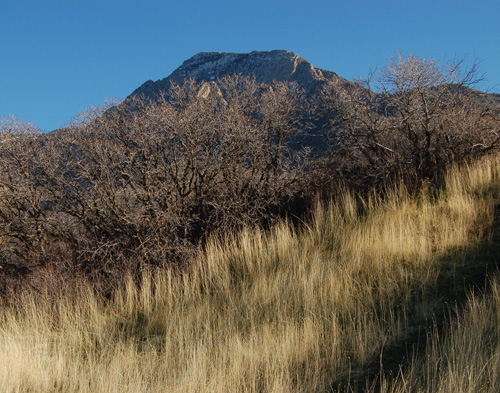
All pictures by Tony Frates
Copyright 2008-2021 Utah Native Plant Society and Tony FratesThe direct link for this page is https://www.unps.org/hybridoak/hybridoak.html First published on the UNPS web site November 17, 2008, updated Nov. 20 thru 26, 2008, with occasional additions since then thru Aug. 2021
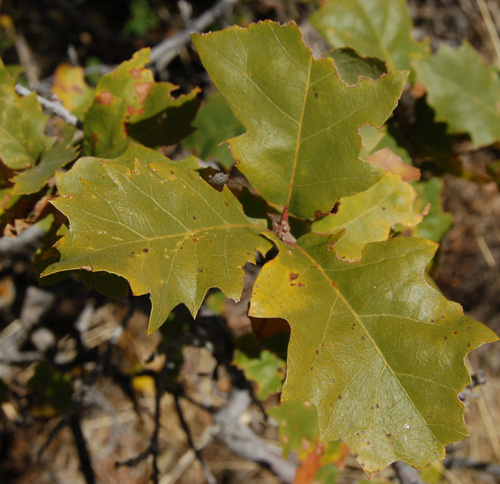
CSE name-year style citation for this article:
Frates AJ. 2008-2021 [cited {access date}]. Naturally occurring rare oak hybrids along the Central Wasatch Front provoke thought and respect [Internet]. Salt Lake City, UT: Utah Native Plant Society. Available from: https://www.unps.org/hybridoak/hybridoak.html - (NOTE: see also the updated article by the same name contained in the Summer 2021 Sego Lily which contains a postscript plus higher resolution as well as additional pictures.)